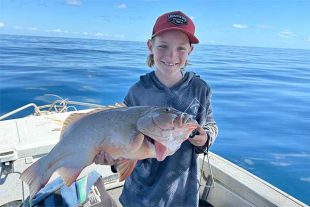New research is using genetic techniques to assess populations of the protected narrow sawfish (Anoxypristis cuspidate) in northern Australia.
Commercial fishers in the Northern Prawn Fishery are working with CSIRO researchers to better estimate the narrow sawfish population and understand the stock structure of this protected species.
They are considered one of the most threatened families of marine fish in the world, with estimates suggesting that only 10 percent of historic populations remain globally.
Narrow sawfish is also an unintended bycatch species in the Northern Prawn Fishery.
Bycatch reduction devices have reduced sawfish landings over the past 20 years, according to Fisheries Research and Development Corporation’s Status of Fish Stocks Reports.
However, information about narrow sawfish population numbers and the status of population growth is lacking.
To address this, fishers in the Northern Prawn Fishery and researchers are working together on an FRDC-funded project using the genetically based close-kin mark-recapture technique to estimate abundance and assess the status of the population.
Working with fishers
Project leader, CSIRO’s Dr Toby Patterson, says industry is supportive of the project.
“They’re keen to be on the front foot in improving management for sawfish,” he said.
All vessels in the Northern Prawn Fishery have sampling kits on board, allowing crew or observers from the Australian Fisheries Management Authority to collect data and tissue samples for the close-kin analysis.
CSIRO pioneered the close-kin mark-recapture technique as part of an FRDC project, which sequences the DNA of sampled sawfish to look for closely related pairs.
“If you have a small population, you’d expect to get a higher proportion of closely related animals,” explained Toby.
“We can then work backward from the incidence of related animals to estimate the abundance of mature animals,” he said.
“From a conservation and management point of view, identifying and conserving the breeding populations is a key goal.

But before the advent of the close-kin technique, there was no practical way we could use to estimate the size of the population,” he said.
Toby said close-kin technique can also provide information on survival rates, based on parent-offspring pairs identified over time, and the sex ratio of the species.
This project will use samples collected as part of previous research, as well as samples collected over the three years of the current project, which is due to end in late 2025.
A second, related project is under way to examine the populations more broadly across northern Australia, taking in the Gulf of Carpentaria, the Northern Territory and the Northern Prawn Fishery.
It includes narrow sawfish, largetooth sawfish (Pristis pristis), green sawfish (P. zijsron), and dwarf sawfish (P. clavata).
This project is co-funded by the National Environmental Science Program and FRDC, with FRDC focusing particularly on the assessment of the post-release mortality component of the research.
Data from the narrowtooth sawfish project will contribute to the broader NESP project, which is being led by Dr Richard Pillans, CSIRO researcher.
The NESP project will end in 2026.
It is using the close-kin technique to assess populations and satellite tagging to assess post-release mortality.
“Building trust and the working relationship between researchers and fishers is a key part of this project,” says Richard.
“We know that numbers of this species in Australia are lower than they used to be, but we don’t know the extent of the decline.
“Assistance from fishers is essential to get a clearer picture of what’s happening.”
He says both projects will contribute valuable information to assess populations, improve management and ultimately support the sustainability of sawfish species.
Under the International Union for Conservation of Nature’s Red List Australian Assessment, narrow sawfish are classified as vulnerable, dwarf sawfish are endangered, and largetooth sawfish and green sawfish are critically endangered.
Catherine Norwood
FRDC
 Bush ‘n Beach Fishing Magazine Location reports & tips for fishing, boating, camping, kayaking, 4WDing in Queensland and Northern NSW
Bush ‘n Beach Fishing Magazine Location reports & tips for fishing, boating, camping, kayaking, 4WDing in Queensland and Northern NSW









